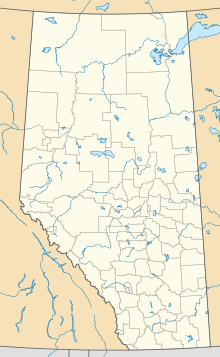Cluny, Alberta
Cluny | |
|---|---|
Hamlet | |
 Location of Cluny in Alberta | |
| Coordinates: 50°50′11″N 112°52′00″W / 50.83649°N 112.86667°WCoordinates: 50°50′11″N 112°52′00″W / 50.83649°N 112.86667°W | |
| Country | Canada |
| Province | Alberta |
| Census division | No. 5 |
| Municipal district | Wheatland County |
| Government | |
| • Type | Unincorporated |
| • Reeve | Glenn Koester |
| • Governing body | Wheatland County Council
|
| Area (2021)[1] | |
| • Land | 0.69 km2 (0.27 sq mi) |
| Elevation | 877 m (2,877 ft) |
| Population (2021)[1] | |
| • Total | 50 |
| • Density | 72.7/km2 (188/sq mi) |
| Time zone | UTC−7 (MST) |
| • Summer (DST) | UTC−6 (MDT) |
Cluny is a hamlet in Alberta, Canada within Wheatland County.[2] It is located 3 kilometres (1.9 mi) south of Highway 1 on a Canadian Pacific Railway line and Highway 843, approximately 87 kilometres (54 mi) southeast of Calgary. It has an elevation of 570 metres (1,870 ft).
The hamlet is located in Census Division No. 5 and in the federal riding of Crowfoot.
The hamlet takes its name from the Parish of Cluny in Scotland.[3]
Demographics[]
In the 2021 Census of Population conducted by Statistics Canada, Cluny recorded a population of 50 living in 24 of its 33 total private dwellings, a change of -28.6% from its 2016 population of 70. With a land area of 0.69 km2 (0.27 sq mi), it had a population density of 72.5/km2 (187.7/sq mi) in 2021.[1]
As a designated place in the 2016 Census of Population conducted by Statistics Canada, Cluny recorded a population of 70 living in 32 of its 41 total private dwellings, a change of 16.7% from its 2011 population of 60. With a land area of 0.69 km2 (0.27 sq mi), it had a population density of 101.4/km2 (262.8/sq mi) in 2016.[4]
See also[]
- List of communities in Alberta
- List of designated places in Alberta
- List of former urban municipalities in Alberta
- List of hamlets in Alberta
References[]
- ^ a b c "Population and dwelling counts: Canada and designated places". Statistics Canada. February 9, 2022. Retrieved February 10, 2022.
- ^ "Specialized and Rural Municipalities and Their Communities" (PDF). Alberta Municipal Affairs. January 12, 2022. Retrieved January 21, 2022.
- ^ Place-names of Alberta. Ottawa: Geographic Board of Canada. 1928. p. 35.
- ^ "Population and dwelling counts, for Canada, provinces and territories, and designated places, 2016 and 2011 censuses – 100% data (Alberta)". Statistics Canada. February 8, 2017. Retrieved February 13, 2017.
- Hamlets in Alberta
- Former villages in Alberta
- Designated places in Alberta
- Populated places disestablished in 1995
- Wheatland County, Alberta
- Southern Alberta geography stubs
